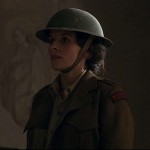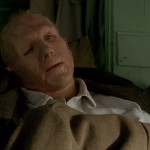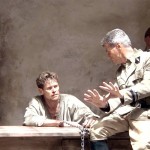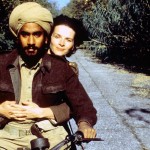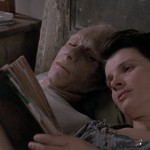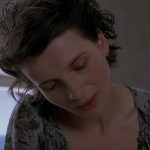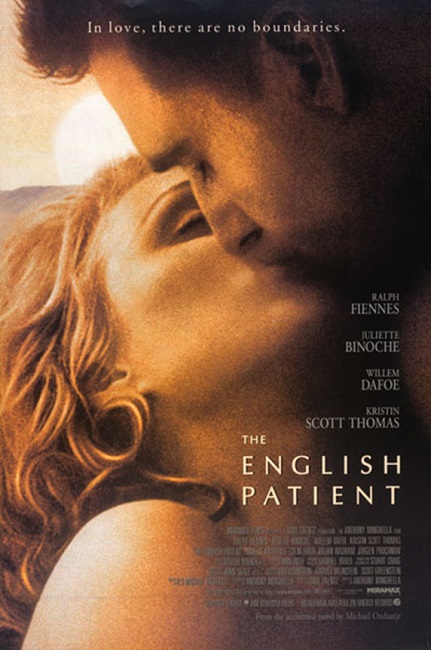
The English Patient – 1996
Here we are back in WWII… again. We are also back in Africa… again. The English Patient, I must admit was not a movie I was looking forward to seeing. I had seen it before a long time ago and was bored to tears. However, I tried to go into it with an open mind. I remembered next to nothing from that first viewing so it was like watching it for the first time… again.
And I’ll be honest, it isn’t nearly as bad as I remembered it to be. However, it was still a slow, slow movie. Not a bad one, but a slow one. It took 3 hours to tell a story that could have been told in an hour and a half. Actually, the first cut of the film was 4 hrs and 10 minutes long. Thank goodness that is was cut down a bit!
The overall plot is actually made up of two different stories, which together made up the greater story. Ralph Fiennes plays the part of Count Laszlo Almasy. He is one of the two characters who appear in both story lines. The other is David Caravaggio, played by Willem Dafoe. The “current” story that starts the movie is continually punctuated with flash-back sequences. Through them, we learn who the burned man is and how he came to be where he was.
The first story takes place in the final days of WWII as the Count is flying a biplane across the Sahara Desert. His mysterious passenger is a woman who appears to be asleep. They are shot down by German forces and the woman is incinerated. The man suffers third degree burns over most of his body but survives. He is saved by desert Arabs and given to the English. He apparently has no memory of who he is or where he came from.
Juliette Binoche is Hana, a French-Canadian nurse who has lost everyone whom she has ever loved in the war. When the English decide that the dying burn victim without a name cannot be saved, they decide to leave him behind and let him die. Hana decides to move him into an abandoned monastery and care for him until his death.
In comes a mysterious vagabond / thief named Caravaggio. He apparently has some sort of connection to the dying man, though he will not say how. Also, Kip, played by British actor Naveen Andrews, an Indian sapper working with the English, arrives to defuse any booby-traps left in the monastery by the Germans. Hana and Kip start a romance together while Caravaggio, who has apparently lost both of his thumbs, interrogates the burn victim.
Slowly, he begins to remember his past and the second story line is revealed. The dying man, Count Almasy, was apparently a cartographer before the start of the war. He and his partner were financed by Geoffrey and Katharine Clifton, played by Colin Firth and Kristen Scott Thomas. He’d had a very passionate love affair with Katharine. Her maddened husband attempts to murder the Count, resulting in his own death and that of his wife as well. Through a complicated series of events, the Count, it is revealed, is indirectly responsible for Caravaggio’s severed thumbs.
And that is it, in a nutshell. It took three hours to tell those two stories. In my opinion, the movie needn’t have been so long-winded. At least an hour could have been safely shaved off and it would have been just as entertaining. So as I often do when I come across a movie that I have such issues with, I have to question: What was it about The English Patient that put it above the rest? Why did it win Best Picture?
First of all, I think the Academy is a sucker for epics and dramas. I get that. I love epics, too, and this was certainly an epic. It had very grand and lofty themes and covered quite an extended period of time. It told its stories of great passion in such a way as to make them engaging to the masses. It dealt with forbidden love, infidelity, revenge, unbelievable loss and sadness, and forgiveness. Many audiences like those kind of lofty themes. They were portrayed with a kind of self-importance that made them seem more weighty than they would normally be.
But the film’s big romance was one that was not at all pure. It was needy and possessive. It was urgent and selfish. The adulterous love affair between the Count and Mrs. Clifton was clearly wrong, by all societal standards. But the overwhelming, all-consuming fire of their passion was portrayed as something so great that it would have been a sin to deny it. It seemed to glorify the concept of illicit relationships as long as the lovers’ passion is strong enough. Fortunately it was balanced out with the smaller, cleaner romance between Hana and Kip. Both of them were unattached and so the romance was unencumbered and honest.
I also have to look at what it was up against. In 1996, the nominees for Best Picture were Fargo, Jerry Maguire, Secrets & Lies and Shine. I’ve seen the first two and while I liked Fargo very much, I don’t think it was any better than The English Patient. I feel the same about Jerry Maguire. But the Oscars went gaga over the English Patient. It was nominated for 12 Academy Awards and won 9. Binoche walked away with the Award for Best Supporting Actress. The film also won for Best Art Direction – Set Decoration, Best Cinematography, Best Costume Design, Best Director (Anthony Minghella), Best Film Editing, Best Original Score and Best Sound.
Next, I’ll look at the individual performances. Our leading man, Fiennes, did a terrific job, just as he always does. He is a very good actor. He was good as the lover, but I thought he was even better as the dying burn victim. The makeup was very good, though I must admit, I don’t really know what a real burn victim looks like. I can say that I THINK it looked realistic.
Interesting note: Fiennes’ burn makeup took 5 hours to apply every day. Fiennes insisted that the full body makeup be applied even for the scenes where only his head would be filmed.
Binoche did a very good job as well. She was gorgeous and had a hidden fire in her eyes that was mesmerizing to watch. She was definitely a screen stealer. She had an ease about her that was endearing and a softness and vulnerability that really made you feel for her character. I have never seen her in a role in which I didn’t like her.
Naveen Andrews was also a bit of a screen stealer. I know him mostly for his role on the television show, Lost. But he was younger here and very sexy. I even thought he looked great in his turban. I have to give him credit for a job well done. I was less impressed with Kristin Scott Thomas and Colin Firth. I felt Thomas could have turned in a deeper performance, though she did well enough. She was nominated for Best Actress, though she did not win. Firth’s role was just too small and under-played to be taken too seriously.
Interesting note: There is a scene in the movie in which Kip must disarm a bomb that is found in a kind of well. It is a tense scene that puts him in danger of being killed. When he reads off the bomb’s serial number to his partner, it is shown to start with “K-K-I-P…” The bomb literally has his name on it.
Willem Dafoe was also pretty good, but for a character to have gone all over the world in search of revenge, only to discover that he could not carry it out when it was time, I think there should have been a more overt shift in his emotions. I’m not saying I know how that should have been shown, but I would have liked to see something more dramatic than simply staring out a window and quietly deciding to forgive rather than punish. He wasn’t even very menacing to the man he had come to murder. I felt no sense of danger when he was trying to force the man to divulge his real identity. But this problem was not with his performance. The problem was in the writing.
I also must mention the cinematography. It was really very well done. The opening sequence of the tiny biplane flying over the desert was beautiful. The shifting patterns in the sands were intriguing and fascinating to see. Another location that was wonderful was the Cave of Swimmers. As a cartographer, Count Almasy found this wonderful archeological site, and he later used it to hide and shelter his lover, Mrs. Clifton, as she died.
Interesting note: The Cave of Swimmers is a real site, and was actually discovered by the real-life explorer Laszlo Almasy, but since its discovery in 1933, it has been a popular tourist site. Unfortunately, years of unchecked tourism and vandalism have reduced the ancient and beautiful art to a horribly damaged state. The cave had to be recreated by a modern artist as a film set for the movie.
The music was written by composer Gabriel Yared. He won the Oscar for Best Original Score, but to be honest, the music didn’t really stand out to me. It was passable and had a distinctly Middle-Eastern flare, but I don’t think it complimented the epic nature of the film very well. It seemed to me to be too small scale. Apparently, the Academy did not agree with my assessment.
Now, all that being said, I don’t think it was a bad movie – just a slow one. The story was interesting enough, I guess. I just don’t think it needed to take 3 hours to tell it. It was simply too slow for my tastes.
Interesting note: At the end of the film, following the previous year’s Best Picture winner Braveheart being called one of the most historically inaccurate movies ever made, The English Patient showed the following message on the screen before the credits began to appear: “While a number of the characters who appear in this film are based on historical figures, and while many of the areas described – such as the Cave of Swimmers and its surrounding desert – exist, and were explored in the 1930s, it is important to stress that this story is a fiction and the portraits of the characters who appear in it are fictional, as are some of the events and journeys.” In other words: Sure, reality is being ignored, but at least we are acknowledging that this movie is historical fiction.
I actually appreciated their honesty.
